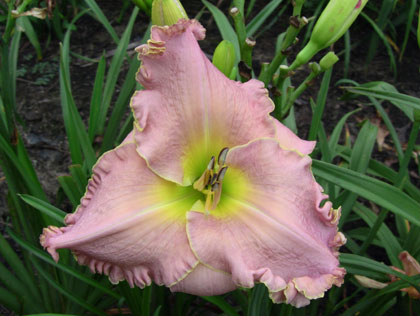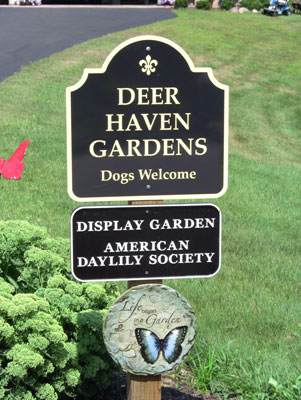
AHS Daylily Display Gardens in Minnesota
Springwood Gardens
Dick and Karol Emmerich
7700 Old Hwy 169 Blvd
Jordan, MN 55352
952-941-9280
email Springwood Gardens
University of Minnesota Landscape Arboretum
Robin Stanislaw
3675 Arboretum Blvd
Chaska MN 50318
612-298-5607
email Robin Stanislaw
Deer Haven Gardens
Dory and Bill Lidinsky
2841 147th Ave NE
Ham Lake MN 55304
cell phone: (763) 913-6763
email Dory and Bill
Would you like to have an AHS Display Garden?
You may notice that our list of AHS Daylily Display Gardens is shrinking! Please consider adding your garden to the list!
Basic Requirements:
- The owner or public garden liaison must be a member of the AHS for two years or more, and must maintain his or her AHS membership in good standing, to be eligible for a garden to be designated as an AHS Display Garden, an AHS Historic Daylily Display Garden, or both.
- Although the number of daylily cultivars is not set, the garden must include a wide variety of daylilies.
- The garden must be well maintained.
Plant markers should be maintained in good condition, with the name of both the cultivar and the hybridizer showing clearly.
- The garden should be open to the public during bloom season.
- Commercial gardens are requested to maintain a specific area designated as a Display Garden.
- The annual renewal application must be returned by October 1.
- A minimum of 50 cultivars registered in, or prior to, 1980 are required to be considered as an AHS Historic Display Garden.
For more details about the application, go to Display Gardens at the AHS website.
The American Hemerocallis Society (AHS) has designated Display Gardens throughout the world. These are the Display Gardens that are located in Minnesota. The gardens are open to the public by appointment.
For Display Gardens in other areas, please visit the AHS website.
We invite you to visit and see what daylily excitement is all about! Bloom season begins in late June, with best viewing during peak in mid-July. These are private gardens, so please contact the owners before your visit.
Garden Etiquette
Garden owners are glad to share their gardens with you, and they want you to have a safe visit. When you go to a Display Garden, please follow these guidelines:
- Call ahead. Let owner know when you have arrived.
- Check with owner about bringing children or pets. Supervise at all times.
- Stay on paths; do not step into beds.
- Do not bring large bags or purses into gardens.
- You are welcome to take photos, but do not set tripods or umbrellas in beds without permission.
- Do not deadhead, pick flowers, or pull weeds.
- Do not take pollen without permission.
- Do not climb on rocks or other landscape features.
- No smoking without permission.
- Wear sturdy walking shoes.
- Enjoy the garden!
Deer Haven Gardens

Who knew? In 1990 we did not even know what a daylily was and now we have a yard full of them and the status of a national AHS display garden.
The journey is a little different for everyone. At first it seemed unbelievable that gardeners would have so much invested in the plants in their garden but suddenly you come to realize that you do too!
Although technically still newbies, we have learned a lot about gardening over the years and now find ourselves in the role of mentors for new members and neighbors.
We started with a limited hybridization program. At first just for fun and later expanded it a bit in an effort to try and achieve certain objectives. There was never a goal to introduce any plants but this year, low and behold, we will be introducing about ten. Limited hybridizing does not necessarily mean small. A few crosses can result in several hundred seeds which eventually will become several hundred clumps. It is a little cooler in the north metro so it takes a few years for our seedlings to reach their full potential. Those we choose not to keep (but still consider to be excellent plants) are given to neighbors. What we are left with is large plants that thrive anywhere in our yard, have high bud count, large blooms and instant rebloom. Initially we had a variety mostly of yellow and orange blooms. To remedy this we have done crosses with stock obtained from other hybridizers has led to more diversity.

Our goals have changed a lot over the years. First of all, we never envisioned having this many plants and flower beds. With the inevitable increase in clump sizes, the addition of more seedlings each year and the acquisition of new cultivars it mounts up quickly. The original plan was to retire in Bemidji (Zone 3) so we were very interested in cultivars that do well in colder climates. We have since decided to remain in the Twin Cities but the climate in the north metro, as mentioned before, tends to be significantly cooler than it is in the southern suburbs so there is still a desire for plants that are best suited for this area (cultivars that thrive and not simply survive). From our experience we still feel purchasing plants from northern hybridizers is still the best strategy for new daylily growers. This will assure the best chance of success with the new additions. Some southern plants do quite well here but it is always an expensive gamble unless you know other growers in the area that have experience with a particular cultivar. Our other goal, to become a display garden, was something that came about much later. It was a natural progression which first began with the creation of a large garden that was suitable for a bus tours and then the decision to officially make it a place where others could visit and learn about daylilies.
There are now over 330 cultivars in our garden. The bloom sizes range from 1 – 14 inches in diameter. Many of the different forms that exist are represented including spiders, unusual forms, doubles and polymerous forms. Initially the collection consisted mostly of tetraploids but over time a large number of diploids have somehow found a home in our garden. In terms of the year of introduction there it is mix of old and new cultivars. The newer cultivars tend to be the best for hybridizing. Many growers work only with the tetraploids but some of the diploids are giving surprising results these days.
I think we have finally found a balance in a yard. It is still small enough to maintain yet provides sufficient space to showcase a variety of different forms and still has room for hybridizing. We have replaced the old timber terraces and black poly edging with more durable retaining wall and landscape bullets. So now you can say our garden is set in stone.
- Bill Lidinsky